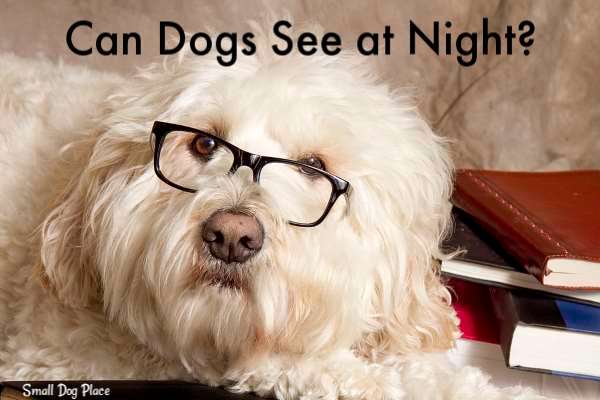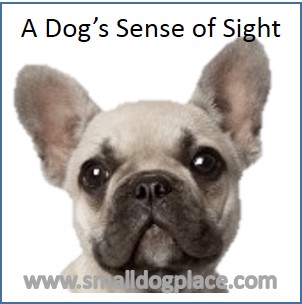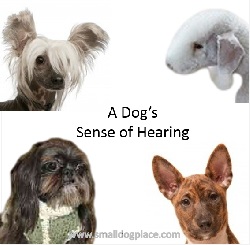Can Dogs See at Night?
Can Dogs See at Night? |Last Updated 1-13-2021
Have you ever wondered if dogs can see at night? You are not alone, many dog owners are curious about the night vision of their dog.
Worldwide, people love to keep dogs as a pet over other pets. There is unique chemistry between dog and human relationship.
Dog’s unconditional love towards their owners is also one of the primary reasons why people prefer dogs as pet. Dog people love to explore interesting things about their dogs, especially their behavior.
Today “Can dog see in the dark” is most searched topic on various search engines. Many dog’s owners wonder whether their dogs are capable of seeing things in the dark. Some people also believe that dogs can’t see color and they are colorblind.
Let's See What the Experts Have to Say About Can Dogs See at Night
According to Dr. Paul Miller from the University of Wisconsin-Madison,
“Dogs have evolved to see well in both bright and dim light, whereas humans do best in bright light. No one is quite sure how much better a dog sees in dim light, but I would suspect that dogs are not quite as good as cats,”
It is true that cats have the best vision in the darkness and dog’s ability to see in the dark is not good as compared to cats.
However, many recent studies have proven that dogs have the capability of seeing color. However, the range of color that dogs recognize is limited as compared to cats and people. We'll talk about that in a moment. First, let's examine how well dogs can seen at night
Can Dogs See at Night?
To answer the question, can dogs see at night, we need to examine the night vision of the dog:
To truly understand and be able to answer the question, "Can Dogs see at night? , we must stop for a quick anatomy lesson.
A Quick Anatomy Lesson of the Dog's Eye
Human and canine eyes are the same but with minor differences.
As compared to humans, dogs have a large pupil.
To review, the pupil is the large circle of the eye in the center of the iris. The iris is the part of the eye that is colored and is found surrounding the pupil. The iris dilates and contracts which causes the pupil to change in size.
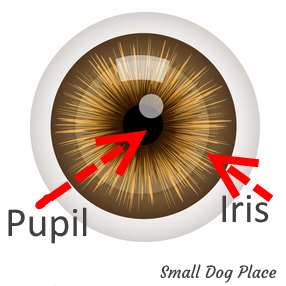 Eye showing the Pupil and Iris
Eye showing the Pupil and IrisWhen the pupil is small, fewer light enters and the reverse is true when the pupil is large. On a sunny day, the pupil will look small, and in the dark, the pupil enlarges. The purpose of the iris and pupil is to let light into the retina.
The retina is that part of the eye that can receive light and images. The retina is where the differences show up in people and the dog’s eye. The retina contains rod and cone cells that help turn the light into the images we perceive.
The rods process low light and the cones work with color and bright light conditions. Dogs have more rods than people, so they have better vision in the dark.
More importantly, dog’s capability to see in the dark depends on Flicker Fusion Frequency or known as Flicker Fusion Threshold.
It is the frequency at which unsteadily light become steadily. Generally, the faster a dog moves, the higher will be Flicker Fusion Frequency.
However, there is also hidden fact about dog’s capability to see in the dark, and it is the tapetum lucidum. This structure is present in many other vertebrates but not humans.
The tapetum lucidum is tissue beneath the retina that is capable of reflecting more light. It is like a mirror within the dog’s eyes that reflects the light that enters it.
This process gives the retina a second opportunity to trace light. Thus, dogs can see in the dark better than we can. There is something else unique with the tapetum lucidum – it changes the appearance of the dog’s eye at night.
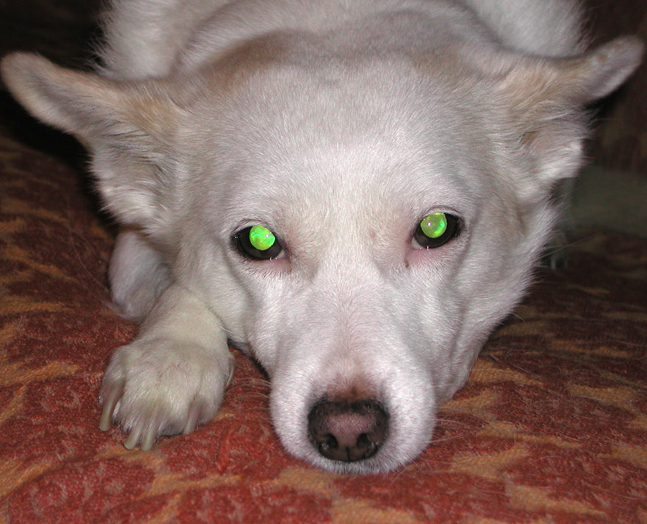 Can Dogs See in the Dark? Bright green, glow as a result of the Tapetum lucidum (Photo, Public Domain)
Can Dogs See in the Dark? Bright green, glow as a result of the Tapetum lucidum (Photo, Public Domain)Why Dogs Eyes Glow in the Dark
You may have noticed that your dog’s eyes glow in the dark, and you may also have seen that your dog’s eye appears to be bright green in color. This color change is the tapetum lucidum at work.
When human eyes recognize light, there is only one chance to perceive light. However, dogs get a second chance because of the Tapetum lucidum as mentioned earlier. This secondary process that dogs possess enhance the night vision of the dog.
Do Different Breeds of Dog See Differently?
Now, you may be wondering whether every dog breed sees the same or differently. Many recent studies have proven that all kinds of dogs perceive the same color spectrum and all have the same capabilities to see in the dark.
However, anatomical differences do exist. Just like some breeds have better olfactory capacities, vision does differ among breeds.
According to Murphy and Pollock as reported by Dr. Miller1, the shape of the head and the placement of the eyes are factors that influence the size of the visual field.
For example dogs with a long nose have a wide field of good vision up to a visual field of 270 degrees as compared to 180 degrees in people. All sighthounds have this same type of head and nose. The short nosed breeds (brachycephalic) are much more like people.
Is Human and Dog Vision Same?
It is true that dogs and people see the world differently. Dogs can see color and see in the dark. On the other hand, we can see colors better than dogs and even, we perceive visual details much better.
However, dogs are much better to detect motion as compared to us. So, the four main differences in vision between dogs and people are night vision, color vision, motion and depth of field.
Color Vision
People have three different types of cones that allow us to see colors from the red to the violet spectrum. Dogs, on the other hand, have two types of cones.
Dogs can see blue and violet colors, but different colors may blend and seem like the same color. This vision would be comparable to people with red-green color blindness. This means that when people see red, the dog will perceive the same object as yellow.
Do Dogs like the Dark?
This depends on the individual dog, and some dogs may be affected by darkness more so than others. It does help to know how your dog reacts to the darkness. Do they prefer to sleep with a light on on in the dark? Your dog may have a sensitivity to dark if
- Your dog seems to be an upset at night
- You see your dog hiding
- Your dog has house training accidents at night.
- Your dog barks excessively when home alone at night.
- Your dog tends to escape at night
You may not want to leave your your pet in complete darkness, even if your dog has better vision in the night. Thus, if you won’t be home in the evening, then make sure to leave one light on so that your dog can easily find his or her way.
How Age Affects Vision?
Vision loss in dogs can be the result of genetics, injuries, infection, and yes, age too. As the dog's age increases, there is a result in retinal cataracts or degeneration.
However, it also varies from dog to dog, and some may not affect by the loss of vision, even when they become old. Fortunately, there are many methods for sustaining the excellent sight, and you can contact your veterinarian for the expert suggestion.
If you Found, "Can Dogs See at Night?" Helpful, May I suggest
References for Can Dogs See at Night
1 Paul E. Miller, DVM, and Christopher J. Murphy DVM, PhD (1995). Vision in dogs. JAVMA, Vol 207, No. 12, December 15, 1995
About Janice (author and voice behind this site)
Janice Jones has lived with dogs and cats for most of her life and worked as a veterinary technician for over a decade. She has also been a small-breed dog breeder and rescue advocate and holds academic training in psychology, biology, nursing, and mental health counseling. Her work focuses on helping dog owners make informed, responsible decisions rooted in experience, education, and compassion.
When not writing, reading, or researching dog-related topics, she likes to spend time with her six Shih Tzu dogs, her husband, and her family, as well as knitting and crocheting. She is also the voice behind Miracle Shih Tzu and Smart-Knit-Crocheting
Does This Article Deserve Your Thumbs Up?
We always appreciate your support and encouragement. Your thumbs up means so much to us. Please like this article.
If you find this page or any page on Small Dog Place Helpful, or useful in anyway, I'd love it if you would click the small heart found on the bottom right of each page.
You can also share or bookmark this page -- just click on the:

Free Monthly Newsletter
Sign Up for Our Free Newsletter and get our Free Gift to You.
my E-book, The Top 10 Mistakes People Make When Choosing a Dog (and how to avoid them)
